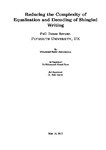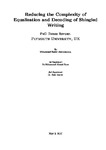Reducing the Complexity of Equalisation and Decoding of Shingled Writing
| dc.contributor.supervisor | Ahmed, Mohammed Zaki | |
| dc.contributor.author | Abdulrazaq, Muhammad Bashir | |
| dc.contributor.other | School of Engineering, Computing and Mathematics | en_US |
| dc.date.accessioned | 2017-05-24T10:51:17Z | |
| dc.date.available | 2017-05-24T10:51:17Z | |
| dc.date.issued | 2017 | |
| dc.date.issued | 2017 | |
| dc.identifier | 10463615 | en_US |
| dc.identifier.uri | http://hdl.handle.net/10026.1/9332 | |
| dc.description | Full version: Access restricted permanently due to 3rd party copyright restrictions. Restriction set on 24/05/2017 by SC, Graduate school | |
| dc.description.abstract |
Shingled Magnetic Recording (SMR) technology is important in the immediate need for expansion of magnetic hard disk beyond the limit of current disk technology. SMR provides a solution with the least change from current technology among contending technologies. Robust easy to implement Digital Signal Processing (DSP) techniques are needed to achieve the potentials of SMR. Current DSP techniques proposed border on the usage of Two Dimensional Magnetic Recording (TDMR) techniques in equalisation and detection, coupled with iterative error correction codes such as Low Density Parity Check (LDPC). Currently, Maximum Likelihood (ML) algorithms are normally used in TDMR detection. The shortcomings of the ML detections used is the exponential complexities with respect to the number of bits. Because of that, reducing the complexity of the processes in SMR Media is very important in order to actualise the deployment of this technology to personal computers in the near future. This research investigated means of reducing the complexities of equalisation and detection techniques. Linear equalisers were found to be adequate for low density situations. Combining ML detector across-track with linear equaliser along-track was found to provide low complexity, better performing alternative as compared to use of linear equaliser across track with ML along track. This is achieved if density is relaxed along track and compressed more across track. A gain of up to 10dB was achieved. In a situation with high density in both dimensions, full two dimensional (2D) detectors provide better performance. Low complexity full 2D detector was formed by serially concatenating two ML detectors, one for each direction, instead of single 2D ML detector used in other literature. This reduces complexity with respect to side interference from exponential to linear. The use of a single bit parity as run length limited code at the same time error correction code is also presented with a small gain of about 1dB at BER of 10^-5 recorded for the situation of high density. | en_US |
| dc.description.sponsorship | Emerging Markets Telecommunication Services Limited (Etisalat Nigeria). | en_US |
| dc.language.iso | en | |
| dc.publisher | University of Plymouth | |
| dc.subject | Complexity | |
| dc.subject | Equalisation | |
| dc.subject | Full 2D Detection | |
| dc.subject | Shingled Magnetic Recording | |
| dc.subject | SOVA | |
| dc.subject | BCJR | en_US |
| dc.subject.classification | PhD | en_US |
| dc.title | Reducing the Complexity of Equalisation and Decoding of Shingled Writing | en_US |
| dc.type | Thesis | |
| plymouth.version | non-publishable | en_US |
| dc.identifier.doi | http://dx.doi.org/10.24382/1166 | |
| dc.type.qualification | Doctorate | en_US |
| rioxxterms.version | NA |
Files in this item
This item appears in the following Collection(s)
-
01 Research Theses Main Collection
Research Theses Main



